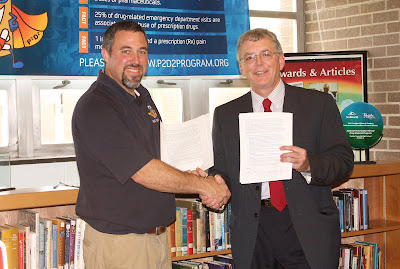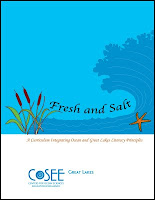May 23rd, 2011 by Irene Miles
From the New York Times:
The Windy City is preparing for a heat wave — a permanent one.
Climate scientists have told city planners that based on current trends, Chicago will feel more like Baton Rouge than a Northern metropolis before the end of this century.
So, Chicago is getting ready for a wetter, steamier future. Public alleyways are being repaved with materials that are permeable to water. The white oak, the state tree of Illinois, has been banned from city planting lists, and swamp oaks and sweet gum trees from the South have been given new priority. Thermal radar is being used to map the city’s hottest spots, which are then targets for pavement removal and the addition of vegetation to roofs. And air-conditioners are being considered for all 750 public schools, which until now have been heated but rarely cooled. Read more.
May 19th, 2011 by Irene Miles
What could have been a dry event was injected with humor when Illinois-Indiana Sea Grant and the National Prescription Drug Disposal Program (P2D2) signed a memorandum of understanding May 10 at Pontiac Township High School (PTHS). Much to the surprise and delight of the people attending, National P2D2 Coordinator and PTHS teacher Paul Ritter dressed like the program’s mascot, superhero Pill Bottle Phil, while tossing P2D2 T-shirts to students.
“In a lot of ways, Ritter is really a superhero kind of guy,” said IISG Director Brian Miller, who co-signed the document. “He’s been traveling all over the country, and it seems like he can be everywhere at once.”
The purpose of P2D2 is to provide communities with a proper method of pharmaceutical disposal that effectively reduces the misuse and abuse of pharmaceuticals as well as improves water quality.
IISG has been working with P2D2 for several years, but signing the MOU officially recognizes the partnership. IISG provides P2D2 with information and helps fund tools for the program, including drug drop boxes, billboard space, and brochures. IISG also produced The Medicine Chest, a compendium of classroom activities, many developed through the P2D2 program.
Many PTHS students and teachers have been integral to the program, and teacher Megan Bozarth’s junior and senior social studies class work closely with P2D2. The students have also been promoting Illinois House Bill 2056, which would create a special fund for pharmaceutical collection and disposal by establishing a $20 fine for people who commit specified drug offenses. If passed, the bill would also provide funding for Illinois police departments to establish pharmaceutical take-back programs so people can properly dispose of their unwanted medicines.
“It’s been amazing to watch how far this has gone,” Miller said.
Also at the signing was Pollution Prevention Program Specialist Laura Kammin, who also serves as IISG’s direct contact with P2D2. “Both IISG and P2D2 work to help communities legally dispose of unused medicines in ways that protect humans, pets, wildlife, and the environment,” Kammin said. “Working together, we can accomplish much more than when we work alone. This is an exciting day for both programs.”
Many of the students spoke at the signing, including Trevor Ross, Kendra Warren, Alex Borgstrom, Debi Johnson, Nora McCune, Beth Guilde, and Tiffany Patterson.
“P2D2 is life changing,” Johnson said. “This program protects our environment, keeps our water clean, and prevents anyone from using these unused drugs and dying from them. This will help make our world a little greener.”
Ritter praised the students, saying they were responsible for more than 145,000 pounds of pharmaceuticals being disposed of properly in Illinois.“We are talking about two semi tractor-trailers full of pharmaceuticals,” Ritter said. “You guys have changed people’s lives in ways that we’ll never actually know if we do our job right.”
May 18th, 2011 by Irene Miles
The new issue of IISG’s newsletter The HELM is now available. This issue covers a number of pressing issues in the Great Lakes and southern Lake Michigan region, including Asian carp and water supply planning in suburban Chicago. Here are some headlines:
• Lake Zurich dips into water supply planning
• Asian carp summit fosters networking, new programs
• Seed grant funding helps projects bloom
• New ‘Clean Boats, Clean Waters’ looking for volunteers
May 16th, 2011 by Irene Miles
From Lake Michigan Shore:
Water quality data collected by Chicago-area volunteers is being used to help Illinois shape the state’s water quality guidelines in conjunction with the U.S. Environmental Protection Agency.
“Our Adopt-a-Beach program has been working with volunteers in Chicago and elsewhere in Illinois and we’ve been closely engaged with partners at the EPA and trying to share our volunteers’ data more broadly,” says Lyman Welch, water quality program manager for the Alliance for the Great Lakes in Chicago. “It’s been an intentional process to share our data with state and federal regulators.” Read more.
May 12th, 2011 by Irene Miles
From the Chicago Tribune:
The Obama administration is ordering an ambitious cleanup of the Chicago River, a dramatic step toward improving an urban waterway treated for more than a century as little more than an industrialized sewage canal.
In a letter obtained Wednesday by the Tribune, the U.S. Environmental Protection Agency demands that stretches of the river must be clean enough for “recreation in and on the water,” a legal term for recreational activities including swimming and canoeing. The order also applies to two connected waterways, the Cal-Sag Channel and Little Calumet River. Read more.
May 11th, 2011 by Irene Miles
Even though Asian carp is considered a nuisance by many in the Great Lakes and Mississippi regions, these fish have been a popular food in China for thousands of years. Because of this fact, experts who took part in Illinois-Indiana Sea Grant’s Asian Carp Marketing Summit (ACMS) have proposed that the invasive species be exported in high numbers back home to Asian markets.
The ACMS was held so various stakeholder groups could discuss opportunities and impediments to commercial marketing of Asian carp as a way to slow the spread of these fish. In addition to exporting, participating experts agreed that another solution could be marketing high-value Asian carp fillets to restaurants and retailers. They also recommended converting Asian carp by-products into pet food or treats to eliminate waste and maximize profit opportunities.
For all this to happen, incentives are needed for anglers, restaurants, and retailers to harvest the fish. For example, increasing the price per pound and lifting fishing restrictions were proposed as possible solutions to entice fishermen. Also, participants said it may be necessary to re-brand the fish to overcome the public’s negative perception.
Attending the meeting were commercial fishers, processors, natural resource managers, marketers, researchers, conservation organizations, aquaculturists, distributors, and restaurateurs from eight different states.
The two-day summit was held from Sept. 20-21 and was sponsored by IISG, the Illinois Department of Natural Resources and the National Great Rivers Research and Education Center.
May 10th, 2011 by Irene Miles
Many college classes are lecture-based and require students to be subjected to an endless amount of PowerPoint slides. However, students here at the University of Illinois have an opportunity to take a class in which they can put away their lecture notes and bust out their thinking caps with ENG 315: Learning in Community (LINC).
“I think students are eager to find authentic, challenging experiences that help them develop skills that are transferable to the job market,” said LINC Co-Director Valeri Werpetinski, of the Center for Teaching Excellence. “Many also want to be more actively involved in the community, and service-learning courses enable them to integrate this goal into their busy academic lives.”
This course partners nonprofit organizations with students, who will address the needs of these entities. One of these nonprofits is Illinois-Indiana Sea Grant (IISG), which is involved in projects geared toward the conservation and practical use of the coasts, especially southern Lake Michigan.
The course allows for students to exercise a great deal of creativity and freedom. Werpetinski said students will spend time in small teams planning and implementing projects that align with the mission and environmental education needs of IISG. They will also teach and collaborate with youth on community stewardship projects.
“Students in this class are given a great deal of responsibility and are provided with leadership and critical-thinking experience,” said Robin Goettel, IISG associate director for education. “A key issue we will be looking at is how to prevent the spread of aquatic invasive species. Students will explore ways to work with community organizations to get that message out to the public.”
For example, college students in 2010 worked with an 8th grade class in making a group of projects that raised awareness about different invasive species. Some children created comic strips and poems that were published in the News Gazette, while others made the song “All the Zebra Mussels” to the tune of Beyonce’s pop song “Single Ladies.”
The LINC program promotes a life-long commitment to learning and service for U of I students by serving as a resource and connecting members of the university community with local non-profit organizations to engage in meaningful service experiences.
April 25th, 2011 by Irene Miles
Fresh and Salt is a collection of activities that enhance teacher capabilities to connect Great Lakes and ocean science topics. Designed to be used by teachers in grades 5-10, Fresh and Salt provides an interdisciplinary approach to ensure that students achieve optimum science understanding of both Great Lakes and Ocean Literacy Principles. This curriculum offers a varied range of instructional modes, including data interpretation, experimentation, simulation, interactive mapping, and investigation.
The 14 activities that make up Fresh and Salt were selected for their capacity to provide science process skills that students need for effective learning. This curriculum can also help prepare students to be responsible decision-makers that promote a sustainable society.
This project was led by IISG with funding and support from COSEE Great Lakes. Visit the IISG website to download or order a copy of Fresh and Salt.
April 22nd, 2011 by Irene Miles
Paris Collingsworth has joined IISG as the new Great Lakes ecosystem specialist. He is working with the U.S. EPA Great Lakes National Program Office to improve access to and sharing of Great Lakes data and research, develop indicators, and develop products and programs to sustain or improve ecosystem health.
Paris has a background in statistical and computer modeling and comes to IISG from a post doc position at the USGS Great Lakes Science Center where he was involved in building models describing how primary productivity patterns and climatic variables influence fish recruitment across the Great Lakes. He has a PhD in evolution, ecology and organismal biology from Ohio State and an MS in zoology from Southern Illinois University.








